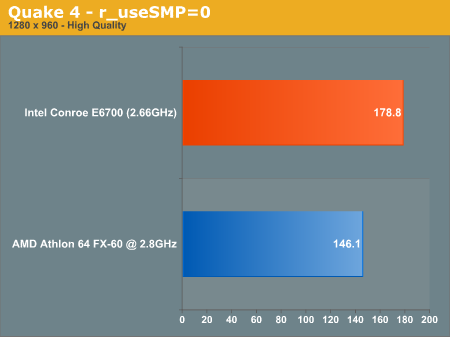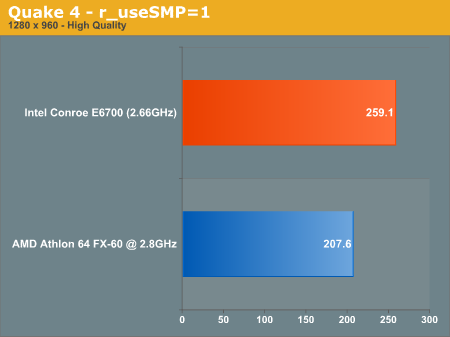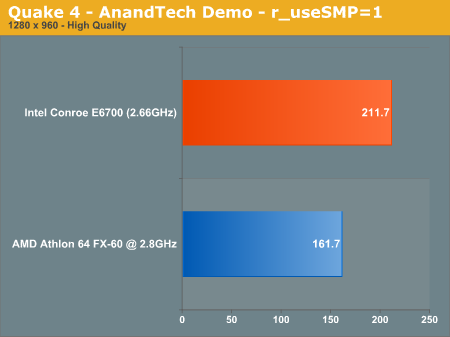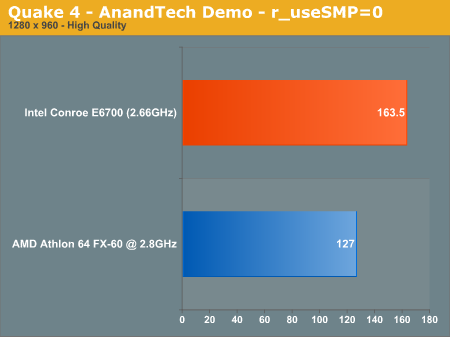Conroe Performance Preview Follow-Up
by Anand Lal Shimpi on March 9, 2006 9:30 AM EST- Posted in
- Trade Shows
The Benchmark Issue
Although we mentioned that there’s not much you can do to make a timedemo really favor one CPU architecture over another, you all demanded that we try with one of our demos. We put our Quake 4 demo file on a USB drive and copied it over to the Conroe and Athlon 64 FX-60 systems that Intel had setup. Note that the version of Quake 4 installed was 1.0.5.0 which is newer than what we test with in our CPU reviews, so you can’t directly compare the numbers to previous AnandTech results but at least we’d be able to see if Intel’s Quake 4 demo was somehow giving Conroe the unfair advantage.
We re-ran Intel’s Quake 4 demo to confirm our initial results. Much to our surprise, we actually short-changed Intel the first time around. We noted that Conroe held a 28% performance advantage over the 2.8GHz Athlon 64 FX-60 with SMP disabled, but with it enabled the performance advantage shrunk to 15%. We re-tested and confirmed our suspicions that Conroe’s Quake 4 performance with SMP enabled was more in line at a 24% advantage:


But what we’re really interested in is how Conroe performed in the very same Quake 4 demo that has been favoring AMD processors in all of our CPU reviews. We loaded up our Quake 4 demo and had at it:


With SMP enabled we see that Conroe holds an even larger 31% performance advantage and with it disabled, the unreleased CPU was 29% faster. If anything, Intel’s own demo was a little more conservative on Conroe and definitely not optimized to make AMD look bad.










96 Comments
View All Comments
PhoenixOrion - Thursday, March 9, 2006 - link
I've never bought an intel chip for over the $200 mark. But with this Conroe initial showing of performance I just might save up an additional $50 and spring one for my own personal build.yacoub - Thursday, March 9, 2006 - link
Aside from the fanboyisms from one side or the other, let's just state the obvious:It's great to see Intel being truly competitive once again, taking the performance lead (once these chips come out to market).
In the meantime, AMD better have something on the AM2 platform that will bring them back within 5-10% of the Conroe performance if they hope to compete. It has been ABnormal that AMD has held BOTH the price and performance crowns in recent months considering that generally one item will have better price and the other better performance. After AM2's release it will likely return it to how it was a couple years ago where Intel held the performance crown by 5-10% and AMD had the better price. In that situation we will see a return to Intel by the money-no-object folks and AMD still championed by the poor and destitute (though I would include myself in that category for now). :)
Googer - Friday, March 10, 2006 - link
According to tomshardware.com socket AM2 suffers from a performance loss when compaired to a similarly configured socket 939 system.http://www.tgdaily.com/2006/02/20/toms_hardware_am...">http://www.tgdaily.com/2006/02/20/toms_hardware_am...
bob661 - Thursday, March 9, 2006 - link
Nice job Anand!! I'm still going to wait till the product arrives and is tested but at least you eliminated as many variables as you could with the Intel systems. It would seem that Intel didn't try anything underhanded but like you said, "...grain of salt."porkster - Thursday, March 9, 2006 - link
Some have been saying AMD are considering releasing socket 775 AMD CPU's besides their AM2 socket line, as a means to expand their market. If this is true AMD is targeting the $$$$ again rather than trying to get a whole community by centring on performace.You'd think there would be some form of Intel ownership on the Socket's use, but AMD are releasing also their server socket which is much like Socket T.
Calin - Monday, March 13, 2006 - link
There are lots of possible problems for AMD processors running on the Intel's socket 775:-memory controller would have no way to access memory (outside of using the FSB)
-AMD processors have no FSB, they use AMD HyperTransport (which is a bit slow to allow access to memory)
-the Socket 775 has no support for HyperTransport from chipset to processor
So, AMD would have to compete against Intel without having any of K8 advantages. Not likely.
However, the transition to a "pins on mainboard" socket (unlike the "pins on processrs" in use at the moment) might make sense, especially after Intel proved the idea good.
psychobriggsy - Thursday, March 9, 2006 - link
Ah, driven of Tech Report eh? People have been commenting about the lack of bacon over there recently.AMD will never release a processor on S775.
S1207 uses LGA like S775, but that's it.
Spoelie - Thursday, March 9, 2006 - link
I just hope this lays to rest the extremely dumb comments I have been reading the past few days regarding this topic.One thing tho I would have preferred to see Intel do, is use the exact same chipset on their mobo, as it is available for Intel systems as well, is it not? Would have taken away any last shred of doubt but I doubt it would have impacted the scores.
Furen - Thursday, March 9, 2006 - link
Looks like Intel's "20% more performance than AMD" claims are true... right now. I wonder how many speed grades AMD can get out of its 90nm K8 in order to battle Conroe when it actually comes out. I'd guess two more speed grades is the most we'll see this year (so a 3.0GHz X2) which certainly wont make up for the ~20% (overall) performance deficit... so it looks like Intel will be spanking AMD at least until the 65nm shrink and maybe until the K8L comes out.chilled - Thursday, March 9, 2006 - link
That's unlikely given Intel want to be promoting their own chipsets which run XFire fine.